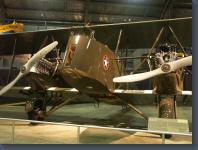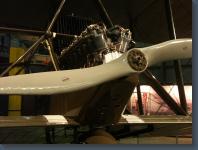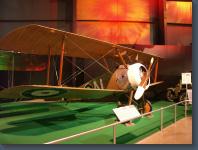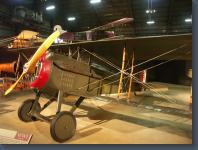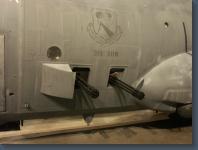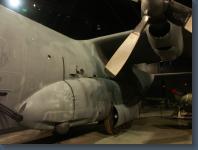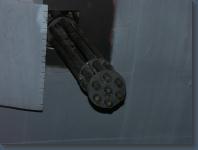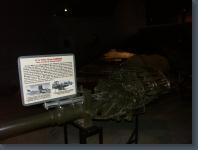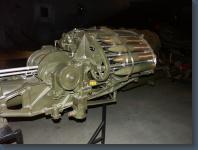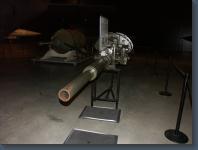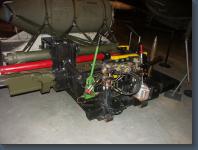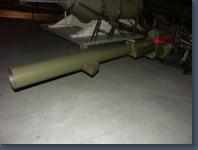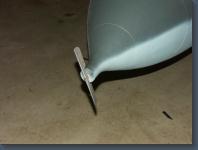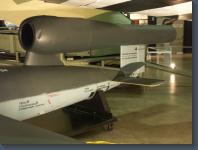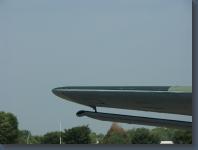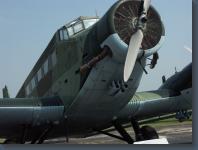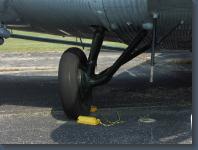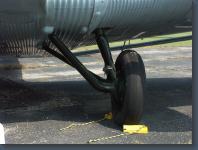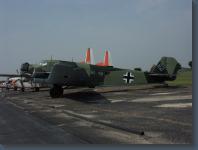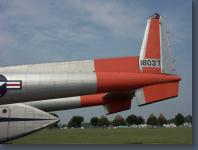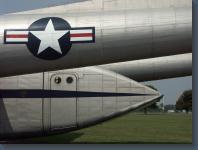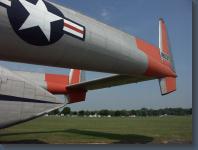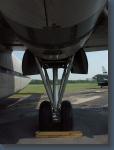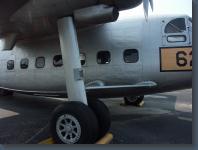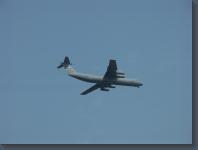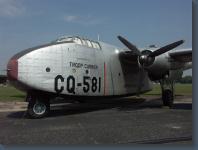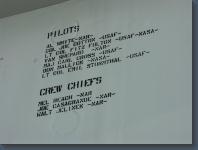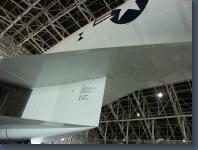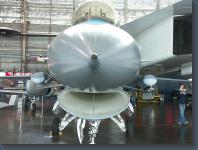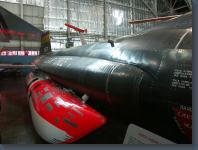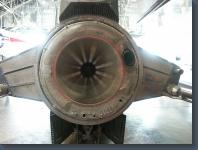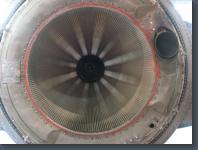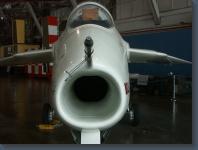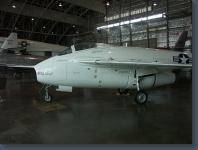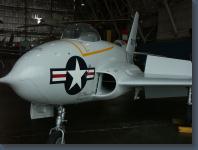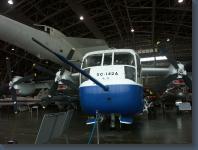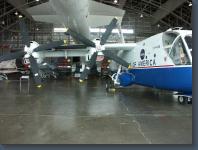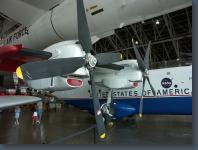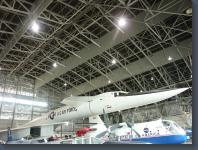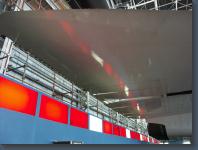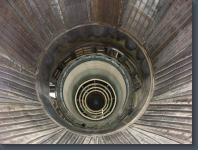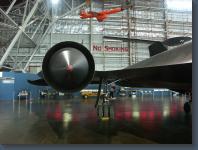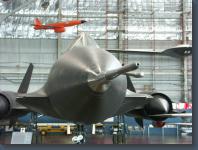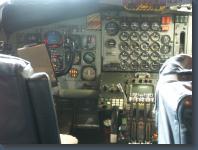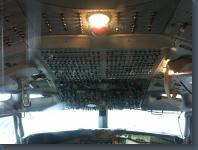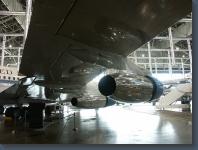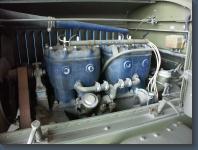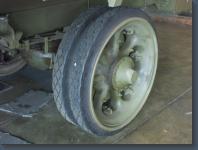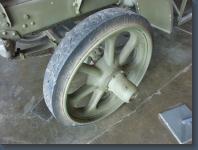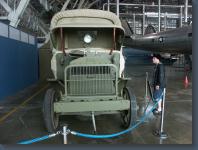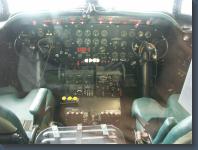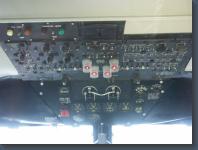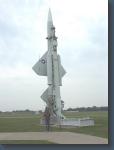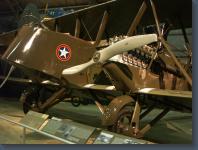
The Martin MB-2 was the first U.S.-designed bomber produced in large numbers. First ordered in June 1920, it replaced the handful of British Handley-Page O-400 and Italian Caproni bombers produced in the United States under license during World War I.
Derived from the MB-1 (or GMB) and designed as a night bomber, the MB-2 sacrificed speed and maneuverability to carry a heavy bomb load. Although more capable than the aircraft it replaced, the MB-2s design reflected conventional features of the time, such as an internal wood structure and fabric covering. It also used the same Liberty engines as previous U.S. Army Air Service bombers.
While the Glenn L. Martin Co. designed the aircraft, it built only the first 20 MB-2s. Under its contracting system, the Army Air Service purchased the design and assigned production to the lowest bidders, which were Curtiss (50 aircraft); Lowe, Willard and Fowler (35); and Aeromarine (25). At the same time, the Army Air Service changed the Martin designation to NBS-1 for Night Bomber Short range.
The MB-2 became the Air Service's primary multi-engine bomber until replaced by the Keystone bombers of the late 1920s. Today, no original MB-2 exists. The reproduction on display at the museum was built using original Martin drawings and completed in 2002.
Wing Fold
The Martin MB-2 designers incorporated an interesting element -- folding wings. Since its large wingspan would have made it difficult to store in a hangar, the aircraft had hinges and notches cut out to allow the wings to be swung from just outside of the engine nacelles.
TECHNICAL NOTES:
Crew: Four
Armament: Five .30-cal. machine guns and maximum 3,000-lb bomb load
Maximum speed: 99 mph
Range: 558 miles
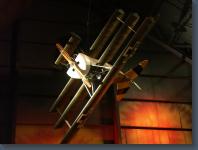
Fokker Dr. I
Few aircraft have received the attention given the Fokker Dr. I triplane. Often linked with the career of World War I's highest scoring ace, Germany's Rittmeister Manfred von Richthofen (the "Red Baron"), the nimble Dr. I earned a reputation as one of the best dogfighters of the war.
The German air force ordered the Fokker Dr. I in the summer of 1917, after the earlier success of the British Sopwith triplane. The first Dr. Is appeared over the Western Front in August 1917. Pilots were impressed with its agility, and several scored victories with the highly maneuverable triplane. Von Richthofen score 19 of his last 21 victories were achieved while he was flying the Dr. I. By May 1918, however, the Dr. I was being replaced by the newer and faster Fokker D. VII.
Although Fokker built a total of 320 Dr. Is, none have survived. This reproduction is painted to represent the aircraft flown by Lt. Arthur Rahn in April 1918 when he served with Jagdstaffel 19. Lt. Rahn is credited with six confirmed victories. The aircraft was placed on display in April 1994.
TECHNICAL NOTES:
Armament: Two 7.92mm Spandau LMG 08/15 machine guns
Engine: Oberursel Ur II of 110 hp or LeRhone of 110 hp
Maximum speed: 103 mph
Range: 185 miles
Ceiling: 19,685 ft.
Span: 23 ft. 7 in.
Length: 18 ft. 11 in.
Height: 9 ft. 8 in.
Weight: 891 lbs. empty; 1,291 lbs. loaded
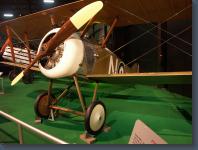
Sopwidth F-1 Camel
The British Sopwith Camel F-1 shot down more enemy aircraft than any other World War I fighter. It was highly maneuverable and very difficult to defeat in a dogfight. Because of its tricky handling characteristics, however, more men lost their lives while learning to fly it than died while using it in combat.
The Camel first went into action in June 1917 with 70 Squadron, Royal Flying Corps, and 4 Squadron, Royal Naval Air Service. Two U.S. Army Air Service squadrons, the 17th and 148th, flew the Camel in combat while assigned to British forces during the summer and fall of 1918. Such famous U.S. pilots as George Vaughn (America's second-ranking Air Service ace to survive the war), Elliot White Springs, Errol Zistel and Larry Callahan were members of the 17th and 148th. A third U.S. unit, the 185th Aero Squadron, used the Camel as a night fighter on the American Front during the last month of the war.
Although 5,490 Camels were produced, very few remain in existence today. USAF personnel built the Camel on display from the original WWI factory drawings, completing it in 1974. The aircraft is painted and marked as the Camel flown by Lt. George A. Vaughn Jr., 17th Aero Squadron.
TECHNICAL NOTES:
Armament: Two Vickers .303-cal. machine guns
Engine: Clerget rotary of 130 hp
Maximum speed: 112 mph
Range: 300 miles
Ceiling: 19,000 ft.
Span: 28 ft.
Length: 18 ft. 9 in.
Height: 8 ft. 6 in.
Weight: 1,482 lbs. maximum
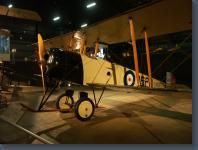
Avro 504K
In July 1913, the British A.V. Roe (Avro) Co. tested its first model 504 aircraft, and numerous variants followed -- based upon the type of engine installed. The 504K version had adapters, which allowed the installation of several different types of rotary engines. This aircraft had an undistinguished combat career, but it proved to be an excellent trainer.
After America entered World War I, it took many months to build the training facilities needed by the U.S. Army Air Service. Meanwhile, many American student pilots went overseas for flight training. Those sent to Great Britain learned on the Avro 504K trainer before advancing to combat aircraft. The U.S. Army Air Service eventually established its main training center at Issoudun, France, and in July 1918, the American Expeditionary Force (AEF) commanders ordered 52 Avro 504K aircraft for teaching aerobatics at Issoudun. After the war, the Army Air Service brought a few Avro 504K aircraft back to the United States, and they remained in training service for a few years.
Using original parts, the Royal Canadian Air Force's Aircraft Maintenance & Development Unit built the aircraft on display in 1966-1967 with a 110-hp Le Rhone J rotary engine. It arrived at the National Museum of the U.S. Air Force in May 2003, and it is painted to represent one of the 52 Avro 504K aerobatic trainers used at the AEF No. 3 Instruction Center, Issoudun, France, in 1918.
TECHNICAL NOTES:
Maximum speed: 95 mph
Ceiling: 13,000 ft.
Weight: 1,830 lbs.
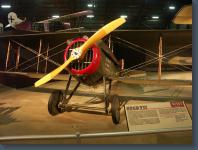
Spad VII
The famed American volunteers of the French Lafayette Escadrille were flying the SPAD VII in February 1918 at the time they transferred to the U.S. Army Air Service, becoming the 103rd Aero Squadron. Several other U.S. units also used the SPAD VII, although most American Expeditionary Force (AEF) fighter squadrons were equipped with a slightly improved version, the SPAD XIII, by the time the war ended in November 1918.
The SPAD VII made its initial flight in July 1916. It showed such promise that it was put into production at once, and by the latter part of that year it appeared on the Front in both French and British squadrons. The airplane was an immediate success, primarily because its structural ruggedness permitted it to dive at high speeds without disintegrating. About 189 of the slightly more than 5,000 SPAD VIIs built went to the AEF.
The airplane on display was obtained from the Museum of Science and Industry, Chicago, Ill., and restored by the 1st Fighter Wing, Selfridge Air Force Base, Mich., 1962-1966.
TECHNICAL NOTES:
Armament: One Vickers .303-cal. machine guns
Engine: Hispano-Suiza 8-Aa of 180 hp
Maximum speed: 127 mph
Ceiling: 17,500 ft.
Span: 25 ft. 8 in.
Length: 20 ft. 3 in.
Height: 7 ft.
Weight: 1,550 lbs. maximum
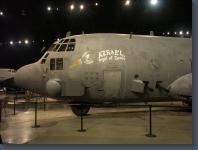
AC-130A Spectre
The AC-130A Spectre is a C-130 converted to a gunship, primarily for night attacks against ground targets. To enhance its armament's effectiveness, it used various sensors, a target acquisition system, and infrared and low-light television systems. The versatile C-130 Hercules, originally designed in the 1950s as an assault transport, was adapted for a variety of missions, including weather mapping and reconnaissance, mid-air space capsule recovery, search and rescue, ambulance service, drone launching, mid-air refueling of helicopters, and as a gunship. The C-130 could transport up to 92 combat troops and their gear or 45,000 pounds of cargo. Where facilities were inadequate, the Hercules could deliver cargo by parachute or by a using a low-altitude parachute extraction system without landing.
The crew of this AC-130A Spectre gunship, named Azrael (Azrael, in the Koran, is the angel of death who severs the soul from the body) displayed courage and heroism during the closing hours of Operation Desert Storm. On Feb. 26, 1991, Coalition ground forces were driving the Iraqi army out of Kuwait. Azrael was sent to the Al Jahra highway between Kuwait City and Basrah, Iraq, to intercept the convoys of tanks, trucks, buses and cars fleeing the battle. Facing numerous enemy batteries of SA-6 and SA-8 surface-to-air missiles, and 37mm and 57mm radar-guided anti-aircraft artillery, the crew attacked the enemy skillfully, inflicting significant damage on the convoys. The crew's heroic efforts left much of the enemy's equipment destroyed or unserviceable, contributing to the defeat of the Iraqi forces. On Feb. 28, 1991, Iraq agreed to a cease-fire.
The aircraft on display was assigned to the 919th Special Operations Wing and was retired to the museum in October 1995.
TECHNICAL NOTES:
Armament: Two 7.62 miniguns, plus two 20mm and two 40mm cannon
Maximum speed: 480 mph
Range: 2,500 miles
Span: 132 ft. 7 in.
Length: 96 ft. 10 in.
Weight: 124,200 lbs. maximum
Serial number: 54-1630
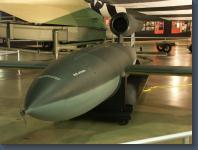
Republic/Ford JB-2 Loon (V-1 Buzz Bomb)
The JB-2 was a U.S.-made copy of the famous German V-1 surface-to-surface, pilotless flying bomb first used against England in June 1944. The Republic Aviation Corp. built the airframe for the JB-2 from drawings prepared at Wright Field, using dimensions taken from the remains of several V-1s brought from Germany. The Ford Motor Co. built the engine, which was a copy of the V-1's 900-lb. thrust Argus-Schmidt pulse-jet.
This JB-2 was obtained from the Continental Motors Corp., Muskegon, Mich., in December 1956.
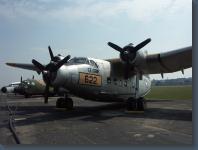
Northrop YC-125B Raider
The Northrop YC-125 was a military version of the Northrop N-23 Pioneer commercial cargo aircraft. The YC-125 series was intended to satisfy two types of missions for the Air Force: troop and equipment transport to forward combat areas and Arctic rescue. The YC-125 was designed to operate from rough, short airfields and to be easily maintained.
Thirteen YC-125As were ordered in 1948 to test the aircraft's ability to haul troops and cargo. Ten additional aircraft were ordered, slightly modified as YC-125Bs, to test their capabilities in the Arctic rescue role. The first flight of the YC-125A occurred on Aug. 1, 1949, and deliveries to the USAF began in 1950. The tests found the aircraft to be significantly underpowered for the intended missions. Furthermore, helicopters were recognized as a better solution for moving troops into forward areas and for performing rescue missions. As a result, the YC-125s were sent to Sheppard Air Force Base, Texas, to be used as ground maintenance trainers. They were declared surplus in 1955.
The aircraft on display is painted to represent the YC-125B used for cold weather testing and based at Wright-Patterson Air Force Base, Ohio, in 1950. It was placed on display in 1995.
TECHNICAL NOTES:
Armament: None
Engines: Three Wright R-1820-99s of 1,200 hp each
Crew: Four
Maximum speed: 207 mph
Cruising speed: 171 mph
Range: 1,856 miles
Service ceiling: 12,200 ft.
Span: 86 ft. 6 in.
Length: 67 ft. 1 in.
Height: 23 ft. 1 in.
Weight: 41,900 lbs. maximum
Serial number: 48-626 (painted as 48-622)
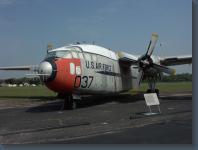
Fairchild C-119J Flying Boxcar
The C-119, developed from the World War II Fairchild C-82, was designed to carry cargo, personnel, litter patients and mechanized equipment, and to drop cargo and troops by parachute. The first C-119 made its initial flight in November 1947, and by the time production ceased in 1955, more than 1,100 C-119s had been built. The USAF used the airplane extensively during the Korean War and many were supplied to the U.S. Navy and Marine Corps and to the air forces of Canada, Belgium, Italy and India. In South Vietnam, the airplane once again entered combat, this time in a ground support role as AC-119 gunships mounting side-firing weapons capable of firing up to 6,000 rounds per minute per gun.
The C-119J on display was specially modified for the mid-air retrieval of space capsules re-entering the atmosphere from orbit. On Aug. 19, 1960, this aircraft made the world's first midair recovery of a capsule returning from orbit when it "snagged" the parachute lowering the Discoverer XIV satellite at 8,000 feet altitude, 360 miles southwest of Honolulu, Hawaii.
The airplane was delivered to the museum in November 1963.
TECHNICAL NOTES:
Armament: None
Engines: Two Wright R-3350s of 3,500 hp each
Maximum speed: 290 mph
Cruising speed: 200 mph
Range: 2,000 miles
Service ceiling: 30,000 ft.
Span: 109 ft. 3 1/4 in.
Length: 86 ft. 5 3/4 in.
Height: 26 ft. 7 3/4 in.
Weight: 66,900 lbs. maximum
Serial number: 51-8037
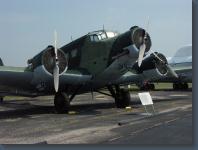
Junkers JU-52 Trimotor
The Ju 52 trimotor, like the USAF C-47, was first built in the 1930s and remained in service for more than a quarter century. This transport made its maiden flight in April 1931, and three years later, a heavy bomber version appeared. The latter aircraft formed the nucleus of the Luftwaffe's infant bomber force in the mid-1930s, and it was used during the Spanish Civil War.
The Ju 52 was obsolete as a bomber by 1939, but because of its durability, simplicity of design and handling characteristics, it continued to serve throughout World War II as a versatile workhorse of the German transport fleet. For a period, Adolf Hitler used a Ju 52 as his private transport. Ju 52s delivered the attacking forces and their supplies during the German invasion of Norway, Denmark, France and the Low Countries in 1940. Almost 500 Ju 52s participated in the historic airborne assault on the island of Crete in May 1941, and Junkers later supplied Rommel's armored forces in North Africa.
Approximately 30 different countries have flown Ju 52s. The aircraft on display was donated to the museum by the Spanish government in 1971. Note: This particular aircraft is a CASA 352L.
TECHNICAL NOTES (transport version):
Armament: Four 7.9mm machine guns
Engines: Three BMW 132T-2 engines of 830 hp each
Maximum speed: 178 mph
Cruising speed: 134 mph
Range: 810 miles
Service ceiling: 19,360 ft.
Span: 95 ft. 11 1/2 in.
Length: 62 ft.
Height: 18 ft. 2 1/2 in.
Weight: 24,250 lbs. loaded
Serial number: T.2B-244 (CASA 352L)
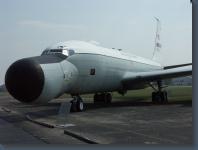
Boeing EC-135E Aria
During the early 1960s, NASA and the Department of Defense needed a mobile tracking and telemetry platform to support the Apollo space program and other unmanned space flight operations. In a joint project, NASA and the DoD contracted with the McDonnell Douglas and the Bendix Corporations to modify eight Boeing C-135 Stratolifter cargo aircraft into Apollo/Range Instrumentation Aircraft (A/RIA). Equipped with a steerable seven-foot antenna dish in its distinctive "Droop Snoot" or "Snoopy Nose," the EC-135N A/RIA became operational in January 1968. The Air Force Eastern Test Range (AFETR) at Patrick Air Force Base, Fla., maintained and operated the A/RIA until the end of the Apollo program in 1972 when the USAF renamed it the Advanced Range Instrumentation Aircraft (ARIA).
Transferred to the 4950th Test Wing at Wright-Patterson Air Force Base, Ohio, in December 1975 as part of an overall consolidation of large test and evaluation aircraft, the ARIA fleet underwent numerous conversions, including a re-engining that changed the EC-135N to the EC-135E. In 1994 the ARIA fleet relocated to Edwards Air Force Base, Calif., as part of the 412th Test Wing. However, taskings for the ARIA dwindled because of high costs and improved satellite technology, and the USAF transferred the aircraft to other programs such as J-STARS (Joint Surveillance and Target Attack Radar System).
On Nov. 3, 2000, a flight crew from the Air Force Flight Test Center delivered the last EC-135E (serial number 60-374, nicknamed Bird of Prey) to the National Museum of the United States Air Force. Over its 32-year career, the ARIA supported the U.S. space program, gathered telemetry, verified international treaties and supported cruise missile and ballistic missile defense tests.
TECHNICAL NOTES:
Armament: None
Engines: Four Pratt & Whitney TF-33-PW-102 turbofans (JT3D) of 18,000 lbs. thrust each
Crew: 11
Maximum cruising speed: 490 knots
Normal cruising speed: 430 knots
Maximum operation altitude: 33,000 ft.
Range: 2800-4500 nautical miles without in-flight refueling (depending on mission and equipment carried)
Span: 103.8 ft.
Length: 141.5 ft.
Height: 41.7 ft.
Weight: 300,500 lbs. maximum takeoff gross weight
Serial number: 60-374
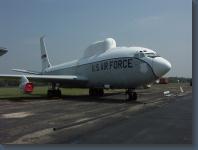
Boeing NKC-135A Stratotanker (Airborne Laser Lab)
While the KC-135A was usually used for in-flight refueling, the Airborne Laser Lab was a modified version used for flight testing. Similar to the commercial Boeing 707, the slightly smaller KC-135 was designed to military specifications and operated at high gross weights. The KC-135A's initial flight occurred on Aug. 31, 1956, and the USAF accepted its first one on Jan. 31, 1957. By 1966, 732 KC-135As had been built, and the aircraft had become the USAF's standard tanker. It was also used for transporting cargo or personnel and by 1970 was serving in other roles, including reconnaissance, electronic intelligence and project testing.
The NKC-135A on display is one of 14 KC-135As permanently converted for special testing. It was extensively modified by the Air Force weapons Laboratory at Kirtland Air Force Base, N.M., and used in an 11-year experiment to prove a high-energy laser could be operated in an aircraft and employed against airborne targets. During the experiment, the Airborne Laser Lab destroyed five AIM-9 Sidewinder air-to-air missiles and a Navy BQM-34A target drone.
The aircraft was flown to the museum in May 1988.
TECHNICAL NOTES:
Armament: None
Engines: Four Pratt & Whitney J57 turbojet engines of 13,750 lbs. thrust each with water injection
Crew: Four (plus 80 troops)
Maximum speed: 606 mph
Cruising speed: 512 mph
Service ceiling: 50,000 ft.
Range: 8,673 miles
Span: 130 ft. 10 in.
Length: 136 ft. 3 in.
Height: 41 ft. 8 in.
Weight: 300,000 lbs. loaded
Serial number: 55-3123
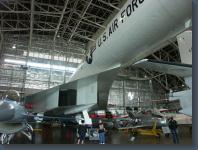
North American XB-70 Valkyrie
The XB-70 was conceived for the Strategic Air Command in the 1950s as a high-altitude bomber that could fly three times the speed of sound (Mach 3). Because of fund limitations, only two were built, not as bombers, but as research aircraft for the advanced study of aerodynamics, propulsion and other subjects related to large supersonic aircraft.
The Valkyrie was built largely of stainless-steel honeycomb sandwich panels and titanium. It was designed to make use of a phenomenon called "compression lift," achieved when the shock wave generated by the airplane flying at supersonic speeds supports part of the airplane's weight. For improved stability at supersonic speeds, the Valkyrie could droop its wingtips as much as 65 degrees.
The No. 1 XB-70 made its initial flight on Sept. 21, 1964, and achieved Mach 3 flight on Oct. 14, 1965. The No. 2 airplane first flew on July 17, 1965, but on June 8, 1966, it crashed following a mid-air collision. The No. 1 airplane continued in its research program until flown to the museum on Feb. 4, 1969.
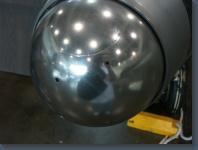
X-15 nose. The holes are for small jets to control the plane's attitude and yaw when the atmosphere is too thin for the control surfaces to work.
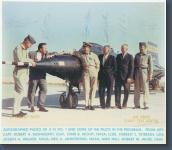
Some X-15 pilots with the plane: Robert Rushworth, John McKay, Forrest Peterson, Joseph Walker, Neil Armstrong, and Robert White.
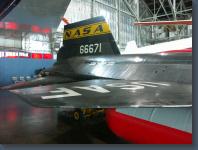
North American X-15A-2
The X-15, designed to provide data on material and human factors of high-speed, high-altitude flight, made the first manned probes into the lower edges of space. It was built for speeds of up to 4,000 mph and altitudes of 50 miles, but these goals were exceeded on numerous occasions. Several X-15 pilots earned "astronaut" rating by attaining altitudes above 50 miles. The X-15 flight program contributed significantly to the Mercury, Gemini and Apollo projects.
The X-15 was carried aloft by a B-52 and was released at about 45,000 feet and 500 mph. Its rocket engine then fired for the first 80-120 seconds of flight. The remainder of the 10-11 minute flight was powerless and ended with a 200 mph glide landing on a dry lake bed.
The first powered X-15 flight was made on Sept. 17. 1959, and 199 flights were made between 1959 and 1968 by the three X-15s that were built. The No. 1 X-15 is at the Smithsonian Institution's National Air and Space Museum, and the No. 3 X-15 was destroyed in a crash. The No. 2 aircraft was retired to the National Museum of the United States Air Force in October 1969.
SPECIFICATIONS:
Span: 22 ft. 5 in.
Length: 52 ft. 5 in.
Height: 14 ft.
Weight: 56,132 lbs. (at launch with ram jet test engine)
Armament: None
Engine: Reaction Motors XLR 99 rocket engine of over 50,000 lbs. thrust
Serial number: 56-6671
C/N: 240-2
PERFORMANCE:
Maximum speed: 4,520 mph (unofficial record)
Range: Over 250 miles (flight path distance)
Service ceiling: 354,200 ft. (unofficial record by X-15 No. 3)
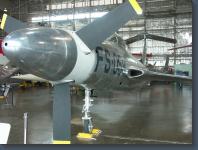
Republic XF-84H
The XF-84H, a joint Air Force/Navy project based on the Republic F-84F, was originally designed to combine the speed of jet aircraft with the long range, low fuel consumption and low landing speed of propeller-driven aircraft. The XF-84H used an Allison XF-40-A-1 turboprop engine in a modified F-84 fuselage. Additional changes included a T-type tail and a triangular fin on the top of the fuselage to reduce the high torque produced by the propeller.
Between July 22, 1955 and Oct. 9, 1956, two XF-84H made 12 test flights. Eleven of the 12 flights ended in emergency landings. Sounds produced by the aircraft's turboprop engine caused nausea and headaches among ground crews, earning the XF-84H the unofficial nickname "Thunderscreech." Though the XF-84H was the fastest single-engine propeller-driven aircraft ever built, it never approached supersonic speed. Due to poor performance and high maintenance requirements, the XF-84H never became operational.
The aircraft on display (S/N 51-17059) was the first of the two prototypes produced by Republic. It flew eight of the 12 test flights. The museum obtained the aircraft from Kern County, Calif., in February 1999.
SPECIFICATIONS:
Span: 33 ft. 5 in.
Length: 51 ft. 5 in.
Height: 15 ft. 4 in.
Weight: 17,892 lbs.
Armament: None
Engine: Allison XF-40-A-1 turboprop of 5,850 shaft hp
Crew: One
PERFORMANCE:
Maximum speed: 520 mph
Range: Beyond 2,000 miles
Service ceiling: Above 40,000 ft.
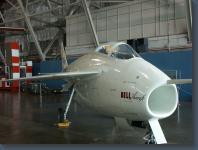
Bell X-5
The X-5 was the world's first airplane to vary the sweepback of its wings in flight. It was built to prove the theory that by increasing the sweepback of an airplane's wings after takeoff, a higher maximum speed could be obtained while still retaining low takeoff and landing speed and higher rate of climb with the wings swept forward. The X-5 was based upon the design of a Messerschmitt P. 1101 airplane discovered in Germany at the end of World War II, although the P. 1101 could vary its sweep only on the ground.
The first X-5 flight was made on June 20, 1951. On the airplane's ninth flight, its wings were operated through the full sweep range of 20-60 degrees.
Two X-5s were built and flown. One crashed and was destroyed on Oct. 13, 1953, when it failed to recover from a spin at 60 degrees sweepback. The other was delivered to the National Museum of the United States Air Force in March 1958.
SPECIFICATIONS:
Span: 32 ft. 9 in. with wings extended; 22 ft. 8 in. with wings swept
Length: 33 ft. 4 in.
Height: 12 ft.
Weight: 9,800 lbs. loaded
Armament: None
Engine: Allison J35 of 4,900 lbs. thrust
PERFORMANCE:
Maximum speed: 690 mph
Cruising speed: 600 mph
Range: 500 miles
Service ceiling: 50,700 ft.
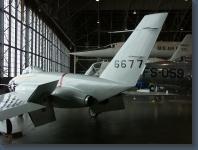
Northrop X-4
The X-4 was developed for the study of flight characteristics of swept wing semi-tailless aircraft at transonic speeds (about Mach .85). Northrop built two X-4s. The No. 1 aircraft was first flown by Northrop on Dec. 16, 1948, and the second X-4 made its initial flight on June 7, 1949. The No. 1 aircraft was grounded after its 10th flight to provide spare parts for the No. 2 aircraft. Northrop's part of the test program ended on Feb. 17, 1950, with the 20th flight of the remaining X-4.
Although both aircraft were turned over to the Air Force and then to the National Advisory Committee for Aeronautics in May 1950, only the No. 2 X-4 was used in the joint USAF/NACA program to explore stability problems near the speed of sound. The program ended in September 1953 with the 102nd and last flight of the No. 2 aircraft, after proving that swept wing aircraft without horizontal tails were not suitable for transonic flight.
Both aircraft survived the test program without serious incident. The No. 1 X-4 is displayed at the Air Force Academy. The No. 2 aircraft was transferred to the museum shortly after the program ended. It was restored by the Western Museum of Flight, Hawthorne, Calif.
SPECIFICATIONS:
Span: 26 ft. 10 in.
Length: 23 ft. 3 in.
Height: 14 ft. 10 in.
Weight: 7,550 lbs. maximum
Armament: None
Engines: Two Westinghouse XJ-30 turbojet engines of 1,600 lbs. thrust each
Crew: One
Serial number: 46-677
PERFORMANCE:
Maximum speed: 640 mph
Cruising speed: 480 mph
Maximum endurance: 44 minutes
Service ceiling: 44,000 ft.
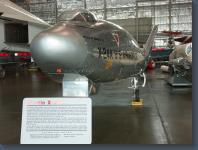
Martin X-24A
Piloted Low Speed Test (PILOT), the third phase of tech START program, investigated the flight characteristics and maneuverability of manned lifting bodies and analyzed the feasibility of using these aircraft for return from space. The X-24A, developed as a joint USAF/NASA project, was basically a large-scale manned version of the SV-5D PRIME vehicle. The ASSET and PRIME phases of the Air Force's START program conducted research in the higher altitudes and speeds, but the X-24 program concentrated on the last stage of re-entry, from about 70,000 feet (21,280 meters) altitude at 1,000 mph (2,609 km/hr) to landing.
The X-24 made its first powered flight on March 19, 1970. It was carried aloft and released at an altitude of about 40,000 feet (13,860 meters) by the same B-52 used in the X-15 program. Upon release, the X-24A pilot ignited the rocket engine which boosted the lifting body to its maximum speed and altitude. From this point, a powerless landing was made on a dry lakebed. The X-24A made 28 powered flights at the Air Force Flight Test Center, Edwards Air Force Base, Calif., during its test program.
The X-24A on display was originally the jet-powered Martin SV-5J, a derivative of the X-24A built for flight training. It was never flown. For display, the SV-5J has been converted to simulate the X-24A. It was donated by Martin in 1971.
SPECIFICATIONS:
Span: 13 ft. 8 in. (4.2 m)
Length: 24 ft. 6 in. (7.2 m)
Height: 10 ft. 4 in. (3.2 m)
Weight: 10,700 lbs. (4,853 kg)
Armament: None
Engines: One Thiokol XLR-11 rocket of 8,000 lbs. (3,625 kg) thrust; two Bell LLRV optional landing rockets of 400 lbs. (181 kg) thrust each
PERFORMANCE:
Maximum speed: 1,036 mph (1,667 km/hr)
Maximum altitude: 71,407 ft. (21,765 m)
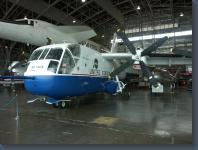
Chance-Vought/LTV XC-142A
The tilt-wing XC-142A was an experimental aircraft designed to investigate the operational suitability of vertical/short takeoff and landing transports. Such an aircraft would permit rapid movement of troops and supplies into unprepared areas under all-weather conditions. An XC-142A first flew conventionally on Sept. 29, 1964, and on Jan. 11, 1965, it completed its first transitional flight by taking off vertically, changing to forward flight and finally landing vertically.
Tilting the wing and engines skyward permitted vertical takeoff like a helicopter and then the wing and engines were gradually tilted forward to provide the greater speed of a fixed-wing aircraft in forward flight. The engines were linked together so that a single engine could turn all four propellers and the tail rotor. In tests the XC-142A was flown from airspeeds of 35 mph backwards to 400 mph forward. XC-142As were tested extensively by the Army, Navy, Air Force and NASA.
The aircraft on display -- the only remaining XC-142A -- was one of five built. It was flown to the museum in 1970.
SPECIFICATIONS:
Span: 67 ft. 6 in.
Length: 58 ft. 2 in.
Height: 25 ft. 8 in.
Weight: 41,500 lbs. maximum
Armament: None
Engines: Four General Electric T64s of 3,080 hp each
Serial number: 65-5924
Other registrations: NASA 522
PERFORMANCE:
Maximum speed: 400 mph
Cruising speed: 235 mph
Range: 820 miles
Service ceiling: 25,000 ft.
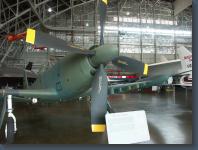
Piper PA48
The Enforcer is a turboprop-powered light close-support/ground-attack aircraft built by Piper Aircraft Corp. Lakeland, Fla. It is based on the well-known North American P-51 of World War II fame. By direction of Congress, the USAF evaluated the aircraft, beginning in 1983. Testing was conducted in 1984 and the Air Force decided not to order the Enforcer.
Since the Enforcer was never in the Air Force inventory, it was not given an official military designation and did not receive an Air Force serial number. Instead, it carries the Piper designation PA-48 and Federal Aviation Administration registration number N481PE. Although the airframe resembles that of the P-51, the Enforcer is essentially a new aircraft.
SPECIFICATIONS:
Span: 41 ft. 4 in.
Length: 34 ft. 2 in.
Height: 13 ft. 1 in.
Armament: Mixed armament includes two GE GPU 30mm gun pods, MK-82 snakeyes, Bristol GRV-7 rockets, CBU canisters and MK-20 Rockeye antitank rockets
Engine: Avco-Lycoming YT-55-L-9 turboprop of 2,445 hp
C/N:48-350001
Registration number: N481PE (no USAF serial number assigned)
PERFORMANCE:
Maximum speed: 403 mph
Range: 921 miles
Service ceiling: 25,000 ft.
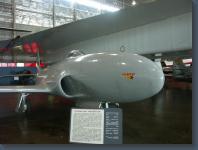
Lockheed P-80R
After World War II, the AAF's quest for the world's speed record (then held by a British Gloster Meteor) brought about the creation of this specialized airplane, the P-80R. It is a high-speed variant of the standard P-80A Shooting Star, with a smaller canopy, redesigned air intakes and a shorter wing with an extended leading edge. In addition, the engine was modified, the armament removed and replaced by a fuel tank, and all drag-producing openings sealed. On June 19, 1947, at Muroc Army Air Field (now Edwards Air Force Base), Calif., Col. Albert Boyd flew the P-80R to a new world's speed record of 623.753 mph, returning the record to the United States after nearly 24 years.
The P-80R is a descendant of the original Shooting Star, the XP-80, which in 1943 was designed and built in only 143 days by a special team headed by Lockheed's Chief Research Engineer, Clarence L. "Kelly" Johnson. First flown on Jan. 8, 1944, the XP-80 was the first American airplane to sustain speeds in excess of 500 mph in level flight. Although WWII ended before any P-80s reached combat, the Shooting Star became the first American jet to enter large-scale production.
The P-80R on display is the only one built. It was shipped to the museum from Griffiss Air Force Base, N.Y., in October 1954.
SPECIFICATIONS:
Span: 37 ft.
Length: 34 ft. 6 in.
Height: 11 ft. 4 in.
Weight: 12,054 lbs. maximum
Armament: None
Engine: Modified Allison J-33-A-21 of 5,079 lbs. thrust (with alcohol-water injection)
Crew: One
Cost: $168,000
Serial number: 44-85200
C/N: 080-1223
PERFORMANCE:
Maximum speed: 623.753 mph
Range: 1,045 miles
Service ceiling: 45,000 ft.
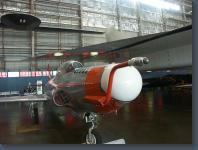
Lockheed NT-33A
The NT-33A was a T-33 trainer adapted as an in-flight simulator assigned to Wright Laboratory and its predecessor organizations. A civilian contractor, Calspan SRL Corp. of Buffalo, N.Y., operated and maintained the aircraft to train hundreds of Air Force and Navy pilots to test advanced aircraft, to examine new control concepts and human factors concerns and to discover potential handling problems in new aircraft. It was used to perform studies in flying qualities, cockpit displays, control sticks and flight control design of aircraft, including the X-15, A-10, F-15, F-16, F-18, F-117 and F-22.
The aircraft, fitted with a Lockheed F-94A nose, had a three degree-of-freedom, response-feedback flight control system that provided independent control of the pitch, roll and yaw motions. The control stick and rudder pedals in the front seat were connected to a computer that was programmed to perform according to the flight characteristics of the aircraft being simulated. As the evaluation pilot moved the controls, the NT-33A responded as would the simulated aircraft. The rear seat was occupied by a safety pilot whose standard controls enabled him to fly the aircraft in the event of a computer malfunction or if the aircraft being simulated proved to difficult to control. During the NT-33A's 40 years of distinguished service, Calspan performed numerous research programs around the country.
The NT-33 conducted its last research project in April 1997 and was flown to Wright-Patterson Air Force Base, Ohio, in May.
SPECIFICATIONS:
Span: 37 ft. 6 in.
Length: 37 ft. 8 in.
Height: 11 ft. 7 in.
Weight: 15,000 lbs. loaded
Armament: None
Engines: Allison J33 of 5,400 lbs. thrust
Crew: Two
PERFORMANCE:
Maximum speed: 525 mph/456 knots
Cruising speed: 455 mph/395 knots
Range: 1,000 miles
Service ceiling: 45,000 ft.
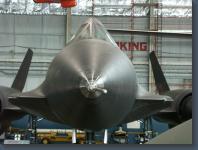
LOCKHEED B-71 (SR-71)
The B-71 designation was used briefly during the development of proposed fighter and (reconnaissance) bomber versions of the Lockheed A-12. The fighter version became the YF-12A, but the bomber version never materialized. A strategic reconnaissance version was built, which kept the bomber sequence number but dropped the bomber designation in favor of the one-of-a-kind SR designation (strategic reconnaissance). The museum has an SR-71A on display in the Cold War Gallery and a YF-12A on display in the Research and Development/Flight Test Gallery.
The SR-71, unofficially known as the Blackbird, is a long-range, advanced, strategic reconnaissance aircraft developed from the Lockheed A-12 and YF-12A aircraft. The first flight of an SR-71 took place on Dec. 22, 1964, and the first SR-71 to enter service was delivered to the 4200th (later 9th) Strategic Reconnaissance Wing at Beale Air Force Base, Calif., in January 1966. The USAF retired its fleet of SR-71s on Jan. 26, 1990, because of a decreasing defense budget and high costs of operation. The USAF returned the SR-71 to the active Air Force inventory in 1995 and began flying operational missions in January 1997. The aircraft was retired again in 1998.
Throughout its nearly 24-year career, the SR-71 remained the world's fastest and highest-flying operational aircraft. From 80,000 feet, it could survey 100,000 square miles of Earth's surface per hour. On July 28, 1976, an SR-71 set two world records for its class: an absolute speed record of 2,193.167 miles per hour and an absolute altitude record of 85,068.997 feet.
Type Number built/
converted Remarks
SR-71A 29 Strategic reconnaissance aircraft
SR-71B 2 Trainer version
SR-71C 1 Hybrid aircraft (YF-12 and SR-71)
TECHNICAL NOTES:
Armament: None
Engines: Two Pratt & Whitney J58s of 32,500 lbs. thrust each with afterburner
Maximum speed: Plus 2,000 mph
Range: Plus 2,900 miles
Service ceiling: Plus 85,000 ft.
Span: 55 ft. 7 in.
Length: 107 ft. 5 in.
Height: 18 ft. 6 in.
Weight: 170,000 lbs. loaded
Crew: Two
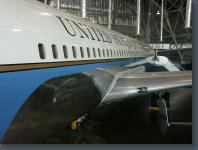
Boeing VC-137C, Air Force One
This U.S. Air Force Boeing VC-137C aircraft (civilian designation 707-320B) was the first jet made specifically for use by the President of the United States. Built in 1962, it served many presidents over three decades, carrying heads of state, diplomats and other dignitaries and officials on many historic journeys.
Popularly known as "SAM 26000" (Special Air Mission; tail number 26000), the aircraft has also been called "Air Force One" -- though this designation was used officially only when the president was aboard. During the 1950s, the call sign of the presidential aircraft was the prefix SAM followed by the aircraft's tail number, and the name "Air Force One" was later chosen to ensure there was no question as to where the president's aircraft was and whether the president was aboard. Because President Kennedy did not name his aircraft as had former presidents, the news media popularized the call sign "Air Force One" as this aircraft's name.
SAM 26000 Served Many Presidents
On Oct. 10, 1962, VC-137C number 26000 entered USAF service directly from the Boeing assembly line in Renton, Wash. President Kennedy had the aircraft painted in striking blue and white instead of the usual military colors to give it a distinctive look. The title "United States of America" was emblazoned on the fueselage and an American flag was painted on the tail. This aircraft carried eight presidents: Kennedy, Johnson, Nixon, Ford, Carter, Reagan, George H.W. Bush and Clinton.
In December 1972 another Boeing 707-320, aircraft 27000, became the primary presidential aircraft and 26000 became a back-up, flying vice presidents and other high-ranking government officials. In 1990 SAM 26000 left the presidential fleet, but it continued to fly government officials, including Secretary of State James Baker. Prior to the 1991 Gulf War, he went abroad in 26000 for talks with Iraqi leaders about removing their troops from Kuwait.
36 Years of Memorable Journeys
SAM 26000 flew President Kennedy to Berlin in 1963, where he declared to West Berliners, "Ich bin ein Berliner," assuring them of continuing United States support in the face of Communist threats and the construction of the Berlin Wall. Kennedy also flew aboard SAM 26000 to Dallas, Texas, where he was assassinated on Nov. 22, 1963 -- and it was on this airplane that Vice President Lyndon B. Johnson was sworn in as the new president. SAM 26000 then carried John F. Kennedy's body and President Johnson back to Washington, D.C. Johnson also used 26000 to visit U.S. troops in Vietnam during the Southeast Asia War.
Beginning in 1970, President Nixon's national security advisor, Dr. Henry Kissinger, used the aircraft for 13 trips to Paris, France, for secret meetings with the North Vietnamese. In February 1972 President Nixon flew aboard SAM 26000 on his historic "Journey for Peace" to the People's Republic of China (the first visit by an American president to China). In May 1972 SAM 26000 carried Nixon to the Soviet Union.
In October 1981 the aircraft flew Presidents Nixon, Ford and Carter, and former Secretary of State Dr. Kissinger to the funeral of the slain Egyptian president Anwar Sadat. In March 1983 Queen Elizabeth II of the United Kingdom flew on SAM 26000 during her trip to the United States when she visited the West Coast.
At a nationally televised event in May 1998, the USAF retired SAM 26000 at the museum. This aircraft provided 36 years of service and accumulated more than 13,000 flying hours.
TECHNICAL NOTES:
Maximum speed: 604 mph
Ceiling: Above 43,000 ft.
Range: 6,000+ miles
Engines: Four Pratt & Whitney TF33 (JT3D-3B) turbofans of 18,000 lbs. thrust each
Load: 40 passengers or 26,200 lbs. of cargo
Crew: 7 or 8
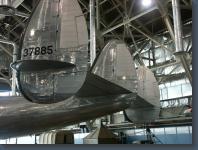
Lockheed VC-121E Columbine III
The C-121 is the military version of the famed Constellation commercial transport. During World War II, the AAF purchased 22 early model Constellations, which were designated C-69s, and between 1948 and 1955 the USAF ordered 150 C-121s for use as cargo and passenger carriers, executive transports and airborne early warning picket ships.
The aircraft on display, the only VC-121E built, was President Dwight Eisenhower?s personal airplane between 1954 and 1961. Mrs. Eisenhower christened it Columbine III in honor of the official flower of Colorado, her adopted home state, in ceremonies on Nov. 24, 1954. Columbine III served as the presidential aircraft until President Eisenhower left office in January 1961. It remained in service transporting government officials and visiting foreign dignitaries throughout the world until it was retired to the museum in 1966.
SPECIFICATIONS:
Span: 123 ft.
Length: 116 ft. 2 in.
Height: 24 ft. 9 in.
Weight: 133,000 lbs. maximum
Armament: None
Engines: Four Wright R-3350s of 3,400 hp each
Cost: $2,647,000
Serial number: 53-7885
PERFORMANCE:
Maximum speed: 330 mph
Cruising speed: 255 mph
Range: 4,000 miles
Service ceiling: 33,600 ft.
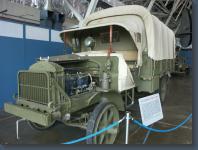
WWI Standard B Liberty Truck
One of the best known Army trucks used in World War I was the 3- to 5-ton Standard B "Liberty" truck. It was designed by the U.S. Army Quartermaster Corps and production began in 1917. In an example of cooperation between the military and the automotive industry, the first pilot models were built only 10 weeks after the design was standardized. Fifteen companies produced a total of almost 9,500 trucks and more than 7,500 of them went overseas. The truck on display is one of the 1,000 built by the Gramm-Bernstein Motor Truck Co. of Lima, Ohio. Four manufacturers built the four-cylinder 52-hp engines. With a four-speed transmission, the "Liberty" truck had a top speed of about 15 mph.
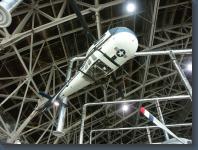
Bell UH-13J Sioux
The UH-13J was the Air Force?s version of the Bell commercial model 47J Ranger helicopter. Two UH-13Js were purchased in March 1957 for use as the first presidential helicopters. On July 13 President Dwight Eisenhower became the first Chief Executive to fly in a helicopter when he took off from the White House lawn in the sister ship of the Sioux on display.
On March 1, 1962, following their assignment as presidential aircraft, the two UH-13Js were assigned to Bolling Air Force Base on the outskirts of Washington, D.C. For the next five years, they were used to carry high-ranking Department of Defense personnel and numerous foreign dignitaries. In July 1967 they were retired from service, one going to the Smithsonian Institution and the other to the National Museum of the United States Air Force.
SPECIFICATIONS:
Main rotor diameter: 37 ft. 2 in.
Tail rotor diameter: 5 ft. 10 in.
Overall length: 43 ft. 4 in.
Height: 9 ft. 4 in.
Weight: 2,800 lbs loaded
Armament: None
Engine: Lycoming O-435 of 240 hp
Cost: $65,000
Serial number: 57-2728
PERFORMANCE:
Maximum speed: 105 mph
Cruising speed: 100 mph
Range: 300 miles
Service ceiling: 17,000 ft.
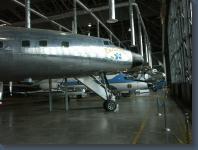
Lockheed VC-121E Columbine III
The C-121 is the military version of the famed Constellation commercial transport. During World War II, the AAF purchased 22 early model Constellations, which were designated C-69s, and between 1948 and 1955 the USAF ordered 150 C-121s for use as cargo and passenger carriers, executive transports and airborne early warning picket ships.
The aircraft on display, the only VC-121E built, was President Dwight Eisenhower?s personal airplane between 1954 and 1961. Mrs. Eisenhower christened it Columbine III in honor of the official flower of Colorado, her adopted home state, in ceremonies on Nov. 24, 1954. Columbine III served as the presidential aircraft until President Eisenhower left office in January 1961. It remained in service transporting government officials and visiting foreign dignitaries throughout the world until it was retired to the museum in 1966.
SPECIFICATIONS:
Span: 123 ft.
Length: 116 ft. 2 in.
Height: 24 ft. 9 in.
Weight: 133,000 lbs. maximum
Armament: None
Engines: Four Wright R-3350s of 3,400 hp each
Cost: $2,647,000
Serial number: 53-7885
PERFORMANCE:
Maximum speed: 330 mph
Cruising speed: 255 mph
Range: 4,000 miles
Service ceiling: 33,600 ft.
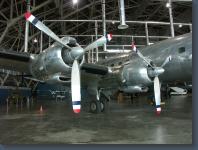
Lockheed VC-121E Columbine III
The C-121 is the military version of the famed Constellation commercial transport. During World War II, the AAF purchased 22 early model Constellations, which were designated C-69s, and between 1948 and 1955 the USAF ordered 150 C-121s for use as cargo and passenger carriers, executive transports and airborne early warning picket ships.
The aircraft on display, the only VC-121E built, was President Dwight Eisenhower?s personal airplane between 1954 and 1961. Mrs. Eisenhower christened it Columbine III in honor of the official flower of Colorado, her adopted home state, in ceremonies on Nov. 24, 1954. Columbine III served as the presidential aircraft until President Eisenhower left office in January 1961. It remained in service transporting government officials and visiting foreign dignitaries throughout the world until it was retired to the museum in 1966.
SPECIFICATIONS:
Span: 123 ft.
Length: 116 ft. 2 in.
Height: 24 ft. 9 in.
Weight: 133,000 lbs. maximum
Armament: None
Engines: Four Wright R-3350s of 3,400 hp each
Cost: $2,647,000
Serial number: 53-7885
PERFORMANCE:
Maximum speed: 330 mph
Cruising speed: 255 mph
Range: 4,000 miles
Service ceiling: 33,600 ft.
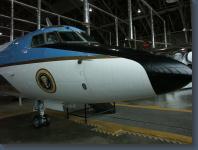
Lockheed VC-140B Jetstar
The C-140 is a military version of the Lockheed Model 1329 light jet transport. The prototype Jet Star was first flown on Sept. 4, 1957, only 241 days after design completion. Production began in 1960.
Although the majority of those produced were built for the civilian market, the USAF bought 16 Jet Stars as C-140As and Bs, the first of which was delivered in late 1961. Five C-140As were assigned to the Air Force Communications Command for use in evaluating military navigation aids and operations. Eleven C-140Bs were assigned to the Military Airlift Command for operational support airlift. Six of them were flown as VC-140Bs on special government and White House airlift missions by the 89th Military Airlift Wing at Andrews Air Force Base, Md.
The VC-140B on display carried Presidents Richard Nixon, Gerald Ford, Jimmy Carter and Ronald Reagan a number of times, although it was not the primary presidential aircraft. Whenever the President was aboard, it flew under the radio call sign Air Force One. This Jet Star ended its 26 years of service when it was flown to the museum on July 16, 1987.
SPECIFICATIONS:
Span: 54 ft. 11 in.
Length: 60 ft. 5 in.
Height: 20 ft. 5 in.
Weight: 41,000 lbs. maximum
Armament: None
Engines: Four Pratt & Whitney J-60 turbojets of 3,000 lbs. thrust each
Crew: Four plus eight passengers
Cost: $1,771,000
PERFORMANCE:
Maximum speed: 598 mph
Cruising speed: 520 mph
Range: 2,200 miles
Service ceiling: 45,000 ft.
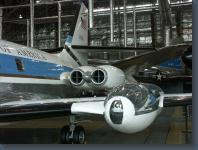
Lockheed VC-140B Jetstar
The C-140 is a military version of the Lockheed Model 1329 light jet transport. The prototype Jet Star was first flown on Sept. 4, 1957, only 241 days after design completion. Production began in 1960.
Although the majority of those produced were built for the civilian market, the USAF bought 16 Jet Stars as C-140As and Bs, the first of which was delivered in late 1961. Five C-140As were assigned to the Air Force Communications Command for use in evaluating military navigation aids and operations. Eleven C-140Bs were assigned to the Military Airlift Command for operational support airlift. Six of them were flown as VC-140Bs on special government and White House airlift missions by the 89th Military Airlift Wing at Andrews Air Force Base, Md.
The VC-140B on display carried Presidents Richard Nixon, Gerald Ford, Jimmy Carter and Ronald Reagan a number of times, although it was not the primary presidential aircraft. Whenever the President was aboard, it flew under the radio call sign Air Force One. This Jet Star ended its 26 years of service when it was flown to the museum on July 16, 1987.
SPECIFICATIONS:
Span: 54 ft. 11 in.
Length: 60 ft. 5 in.
Height: 20 ft. 5 in.
Weight: 41,000 lbs. maximum
Armament: None
Engines: Four Pratt & Whitney J-60 turbojets of 3,000 lbs. thrust each
Crew: Four plus eight passengers
Cost: $1,771,000
PERFORMANCE:
Maximum speed: 598 mph
Cruising speed: 520 mph
Range: 2,200 miles
Service ceiling: 45,000 ft.
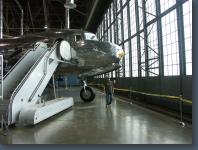
Douglas VC-54C Sacred Cow
When President Franklin D. Roosevelt flew to the Casablanca Conference in 1943 on board a commercial Boeing 314 Clipper Ship, he became the first U.S. president to fly while in office. Concerned about relying upon commercial airlines to transport the president, the USAAF leaders ordered the conversion of a military aircraft to accommodate the special needs of the Commander in Chief.
After encountering difficulties with converting a C-87A transport, the USAAF arranged with Douglas Aircraft to construct a new transport aircraft specifically for presidential use. Nicknamed the Sacred Cow, this VC-54C became the first military aircraft to transport a U.S. president when President Roosevelt took it to the USSR for the Yalta Conference in February 1945.
The first purpose-built aircraft to fly the president of the United States, the Sacred Cow is the only VC-54C ever constructed. To an untrained eye, it looks like any other C-54, but the Sacred Cow is unique. Beginning with a C-54A fuselage and C-54B wings, Douglas made numerous modifications. For example, the ailerons are different from any B model. Furthermore, the Sacred Cow underwent extensive interior modifications. One special feature is an elevator behind the passenger cabin to lift the president in his wheelchair in and out of the plane -- an otherwise difficult procedure. The passenger compartment includes a conference room with a large desk and a bulletproof picture window.
President Roosevelt used the Sacred Cow only once before his death in April 1945; however, the Sacred Cow remained in presidential service during the first 27 months of the Truman Administration. On July 26, 1947, President Truman signed the National Security Act of 1947 while on board the Sacred Cow. This act established the Air Force as an independent service, making the Sacred Cow the "birthplace" of the USAF.
The USAF later assigned it to other transport duties, and the airplane was retired in October 1961. In 1983 the Sacred Cow was shipped by truck to the National Museum of the United States Air Force. The monumental task of restoring the aircraft began in August 1985, and it took 10 years and more than 34,000 hours of work to complete. Appearing as it did during President Roosevelt's trip to Yalta, the Sacred Cow provides a wonderful exhibit for visitors and a superb example of the craftsmanship, skill and perseverance of the museum's Restoration Division staff and volunteers.
SPECIFICATIONS:
Span: 117 ft. 6 in.
Length: 93 ft. 5 in.
Height: 27 ft. 7 in.
Weight: 80,000 lbs. loaded
Armament: None
Engines: Four Pratt and Whitney R-2000 engines of 1,450 hp each
Crew: Seven (plus 15 passengers)
Serial number: 42-107451
PERFORMANCE:
Maximum speed: 300 mph
Cruising speed: 245 mph
Range: 3,900 miles
Service ceiling: 30,000 ft.
